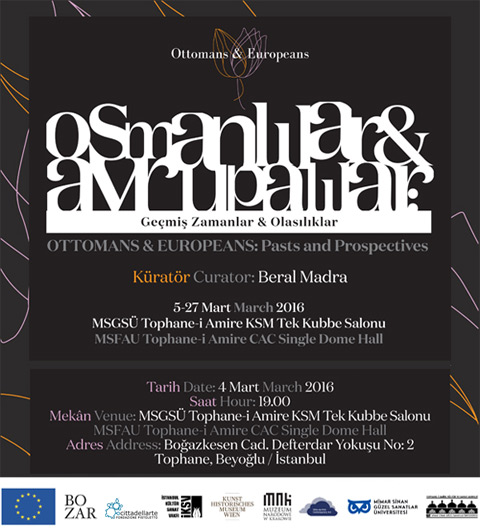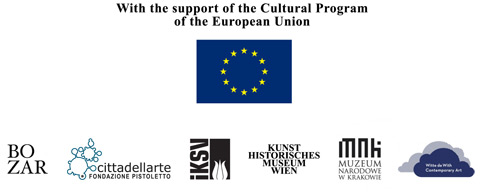Ottomans & Europeans – Blind Dates
Ottomans & Europeans, reflecting on five centuries of cultural relations

Conclusive exhibition from 5 to 27 March 2016 in Istanbul, opening 4 March.

Cittadellarte – Fondazione Pistoletto, July 2015
Istanbul, March 2016
The “Blind Dates” project, lead by Cittadellarte – Fondazione Pistoletto in collaboration with the Istanbul Foundation for Culture and Arts, and curated by Beral Madra, intends to stimulate creative encounters between young and senior generations of European artists with artists from Turkey. The key objective is to explore the field of the relations between Europe and Islamic cultures from the point of view of socially engaged contemporary art: critical theory, art-praxis and relational aesthetics will be used to discuss and explore global themes of mutual interest such as the image of the other, the migration of minorities, the impact and relevance of cultural activism, past and present cultural mobility, secularity versus laicism, spirituality and monotheisms, the idea of the individual and the collective in the western european and islamist cultures.
The project consists of a three weeks residency in Cittadellarte – Fondazione Pistoletto in Biella (Italia) involving six young artists, followed by activities and exhibition scheduled in Turkey in 2016. Six senior artists and various experts and intellectuals from Turkey and Europe will join the residency for a shorter period.
The artists are expected to share their ideas and generate reflections and artistic responses such as performances, presentations, concerts, or a public dialogue at the end of the session.

Junior participant artists: Erol Eskici / Leone Contini / Eda Gecikmez / Mary Zygouri / Driant Zeneli / Naci Gunes Guven
Senior participant artists: Adrian Paci / Gulcin Aksoy / Ergin Cavusoglu / Guven Incirlioglu / Michelangelo Pistoletto
with the theoretical contribution of Prof. Massimo Campanini
Open studio at Cittadellarte – Fondazione Pistoletto
17th July 2015, 5.00 pm
curated by Beral Madra with the coordination of Cittadellarte’s team
curated by Beral Madra with the coordination of Cittadellarte’s team
“Blind Dates” is a strand of the project “Ottomans & Europeans” by BOZAR, Brussels and KUNSTHISTORISCHES MUSEUM – VIENNA, THE NATIONAL MUSEUM – KRAKOW WITTE DE WITH – ROTTERDAM, CITTADELLARTE-FONDAZIONE PISTOLETTO and THE ISTANBUL FOUNDATION FOR CULTURE AND ARTS; it is a EU funded project which proposes a journey through five centuries of shared cultural history between Europe and Turkey.
It consists of two major exhibitions, "The Sultan’s World. The Ottoman Orient in Renaissance Art", BOZAR, in Brussels, (from 27/02/2015 to 31/05/2015) and "Ottomania. The Ottoman Orient in Renaissance Art", Krakow National Museum, in Krakow (from 26/06/2015 to 27/09/2015). The exhibitions propose to showcase the results of artistic exchanges between Europe and the Ottomans during the Renaissance and will stimulate artistic encounters and discussions on EU-Turkish cultural relations today.
Open studio at Cittadellarte – Fondazione Pistoletto
17th July 2015, 5.00 pm
curated by Beral Madra with the coordination of Cittadellarte’s team
Artists in residence:
Leone Contini/ Erol Eskici/ Eda Gecikmez/ Naci Gunes Guven/ Driant Zeneli/ Mary Zygouri

Driant Zeneli, How to dig into the future - 2015

Eda Gecikmez, Searching - 2015

Leone Contini, Landings #1 - 2015
Artists' proposals:
Landings
by Leone Contini
Two “collections” of objects are the occasion to investigate power relations - and often their ambivalence - across the Mediterranean Sea.
1) Several clothes found on the seashore in Sicily, in August 2014. They belonged to migrants landed in Sicily from North Africa with a fishing boat. I collected and washed them. Few days later I realized that a fisherman shot a video of that specific landing, and posted it on youtube. According to the video they all managed to reach the beach, that was about 30 /40 meters distant from the vessel. The migrants left their wet and dirty clothes on the seashore in order to dress clean ones. And they ran away before the arrival of police.
2) A collection of images (old postcards and photographs, drawings, maps) and texts dealing with the topic of Italian imperialism and hegemony in the Mediterranean sea. The historical frame is the Italian colonial past (whose brutality is often denied), with a special focus on the Italian presence in Libya after the Italian-‐Turkish war in 1911.
Part of the material consists in documents from my family archives. In fact my grandparents met each other in Libya – where they both lived – and my mother was born in Tripoli.
Part of the material consists in documents from my family archives. In fact my grandparents met each other in Libya – where they both lived – and my mother was born in Tripoli.
Erol Eskici
My focus is on the countries of the former Ottoman Empire. I am researching on why mostly those countries are instable and often end up in chaotic political situations. Today all those countries are referred to be one “hot conflict zone”. Beyond all the strategic operations and the interventions of the hegemonic power, such as companies and supercountries, there is an important “living” fact. People are fact. The borders that were built after the fall of the Ottoman Empire were based on colonial interests instead of etnical populations. A hundred years later, today, those superficial borders are falling apart again.
The installation will consist of 15 mounds of soil installed on the floor. The soil will be brought from the original countries. But due to conflicts and chaotic situations that might be impossibile. Each mound will be equipped with the sound and movement to represent “breathing”. By using the smell of the soil and the sound of the breathing I want to create a multisensorial experience.
The installation will consist of 15 mounds of soil installed on the floor. The soil will be brought from the original countries. But due to conflicts and chaotic situations that might be impossibile. Each mound will be equipped with the sound and movement to represent “breathing”. By using the smell of the soil and the sound of the breathing I want to create a multisensorial experience.
Pigeons
A collaboration between Leone Contini and Erol Eskici
The homing pigeon is known for its ability to return to its territory after travelling away from it. The project consists in the attempt to exchange messages between an Italian and a Turkish artist, across the Adriatic Sea and the Balkans. At the core of the project this homing instinct, not yet fully explainable: the human communication is here mediated by the skill of this animal, whose geographical intelligence - perhaps based on Earth’s magnetism - is literally above the geopolitical-artificial-fragmentation of the globe. (In other terms is the geographical globe versus the political one).
Related relevant topics:
• The value of an obsolete form of communication in the era of hyper-communication – there is a consistent risk that the pigeon will get lost and the message will never arrive (and risk implies value).
• The homing pigeons were intensively used during WW1, this use of an animal instinct within the modern war is paradoxical.
• The bird-eye is comparable with the airplane-aerial perspective, and the airplane-aerial perspective is, according with Stephen Kern in The Culture of Time and Space, 1880-1918, a crucial transformation of the understanding of space-time in the modernity, and of course this is again related with WW1.
How the bird eye can play with these paradoxes and address the contemporary topics such as the migrations and other forms of global displacement?
Eda Gecikmez
1st Project: "Waiting - Searching - A Suggestion"
Performance and Video Installation
In this project I focus on the immigrant issue in Italy by poetic way. During my visit of the city of Genoa I met African artists who are immigrants there. One of them is a tailor who makes traditional African dresses for musicians and dancers. I wear one of his African dress – custom made for my body shape – and walk through the city of Biella and the Genoa’s seaside.
2nd Project: "Nymphs"
I look into the relations between nature and African fabrics through photography.
3rd Project
I will reflect my surrealistic approach on African fabrics by painting at Istanbul.
Naci Gunes Guven
Archaeology as a study of human activity in the past started in the Ottoman Empire in the 19th century. The attempt was part of the westernization project and a very problematic one. archaeology and museum policies are signs of cultural potency. Archaeological excavation sites and archaeological objects have an inherent authenticity. Even a photo of an artificially produced object which gives an impression of having an archaeological value is generally mistaken as authentic in the eye of the viewer. The main reason for this misunderstanding is the assumption of photography as a reflection of the physical world’s reality. We experience reality through photography. When something other than photography like computer generated imagery is too similar to photography in technical terms, we are inclined to call it real. Vilém Flüsser writes about “image worship”, where he talks about experiencing reality through technical images as in photography. Photography has the potential to create its own realm through any object. Thus, reality becomes something ascribed to photography.
My project is about creating artificial excavation and archaeological site models referring to real ones and then filming the artificial model from top in order to create an authentic, epic and at the same time artificial impact on the viewer.
How to dig into the future
by Driant Zeneli
History is like a kingdom: partly based on documentation, partly reinvented by memory and finally ruled by desire. How do we give a function to the history today? Digging like a virtual contemporary archaelogist I came across the new model of building hotels and resorts in the south of Turkey in the last twenty years. Those buildings are inspired by famous monuments and cities from all over the world, such as Venice, Amsterdam, or Moscow, etc.
My focus is the image and the imaginary evoked by these structures. The project I aim to realize in the south of Turkey will be a sort of “mockumentary” (fake documentary) on the history of these buildings and the people who inhabit them; a kind of documentary projected into the future. I intend these architectures as archaeological pieces of a future that will come. And I ask myself if in the future time the ruins of Amsterdam or Venice will be found in Turkey…
How do we hold ourselves in the present, rethink the past and challenge the future of time?
A collaboration between Driant Zeneli e Naci Gunes Guven
What emerged from these days discussions we had together was the theme of archaeology as a mean of power for the manipulation of history. We also talked about how ancient architecture is interpreted throughout history with an intention to build images of power and 4 how interpreting ancient architecture has an inherently artificial nature. The central focus has been how to challenge the politics of archaeology in contemporary society.
We have in mind of making a video performance in which a man is swimming in a circular shape with a statue on his back from classical period made out of styrofoam. The aim of the project is to use the body as a basis of the statue itself. Thus the performer will make a circular shape inside the water and at a certain point we will have a front view of the statue breaking apart and the performer will keep on swimming as if nothning happened.
The Hamam of the Constitution \\ The Freedom Hamam
by Mary Zigouri
Location: “Hurriyet Hamami”, Tarlabasi, Central Istanbul.
On the façade of this building, founded on 1911, is written “The bath of the Constitution” in three languages: greek, armenian, ottoman turkish. According to the historical sources, the hamam opened in 1908, giving the name to the “Second Constitution Era”.
On the 23rd July of 1908 Sultan Abdülhamid II (r. 1876-1909) restored the constitution; the new era held the promise of “freedom, equality and justice” for all citizens. Muslims and non-Muslims, as well as the various ethnic communities – Greeks, Bulgars, Macedonians, Armenians, Arabs, Kurds, Jews and Turks. Their goal was to “save the empire”, and to reform it so that its multi-religious, multi-ethnic society could survive in the world of the Twentieth Century. Giving representation to local élites - Muslim and non-Muslim, Turk and non-Turk. The period of celebration came to an end in late August.
After that a counter-revolution period arrives. The result of this “failed” movement among others caused the Armenian Genocide.
During the one week-laboratory on the site, the “hurriyet hamami” will be tranformed into a space of artistic-social and political action and production. I will use a methodology that will involve the local community, activating the participation of Turkish, Armenian and Greek artists of Istanbul.
The final event at the end of the week will be a public event – a participatory performance, How we can celebrate a failure-the withdrawal of a possibility-moment, in collaboration with Eda Gecikmez –, on the theme of the Constitution of the past and today. A Constitution under the special corporeal circumstances that a hamam can offer... (such as heat, vapor and water). The performance will be documented and represented as the piece for the final exhibition of the entire project.


